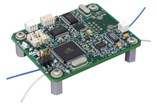Pharad Now Offers Four Dither-Free Modulator Bias Controller Models

Pharad has extended its range of easy-to-use dither-free modulator bias controllers for OEM applications.
The bias controllers work to automatically adjust the modulator bias voltage and maintain its set point as it drifts over time. Since the boards feature dither-free control, the pilot tones found in conventional bias controllers are avoided, making the Pharad models the ideal solution for high performance analog fiber optic links.
The Pharad OEM bias controllers eliminate the need for user supplied external optical couplers, allowing them to be readily integrated into systems. They provide accurate and highly stable bias voltage control of electro-optic modulators and operate with devices having both periodic and non-periodic transfer functions, including lithium niobate and gallium arsenide modulators.
The Pharad dither-free bias controller OEM boards are offered in two form factors; an ultra-compact version and a direct mount configuration that provides sufficient space for directly attaching the modulator. Continuous tuning of the modulator bias voltage is enabled via a standard RS-232 communications interface. Ethernet control of the modulator bias point is also available as an option.
Pharad will be showcasing its full range of bias controller models at the upcoming Exhibition which is part of the IEEE Photonics Conference being held in Burlingame, CA during Sept. 24-27 2012.
About Pharad, LLC
Located in Glen Burnie, Maryland, Pharad, LLC is a customer focused company and technology leader in the development and manufacture of highly efficient, electrically small antennas and RF over fiber systems for communications and defense applications. Pharad creates innovative solutions for realizing difficult-to-engineer antennas for confined operational environments and very broadband applications. Pharad also manufactures a range of high performance RF photonic transceiver products that can support the fiber optic remoting of RF signals up to 40 GHz via a single transceiver module. For more information, visit www.pharad.com.
Source: Pharad, LLC
